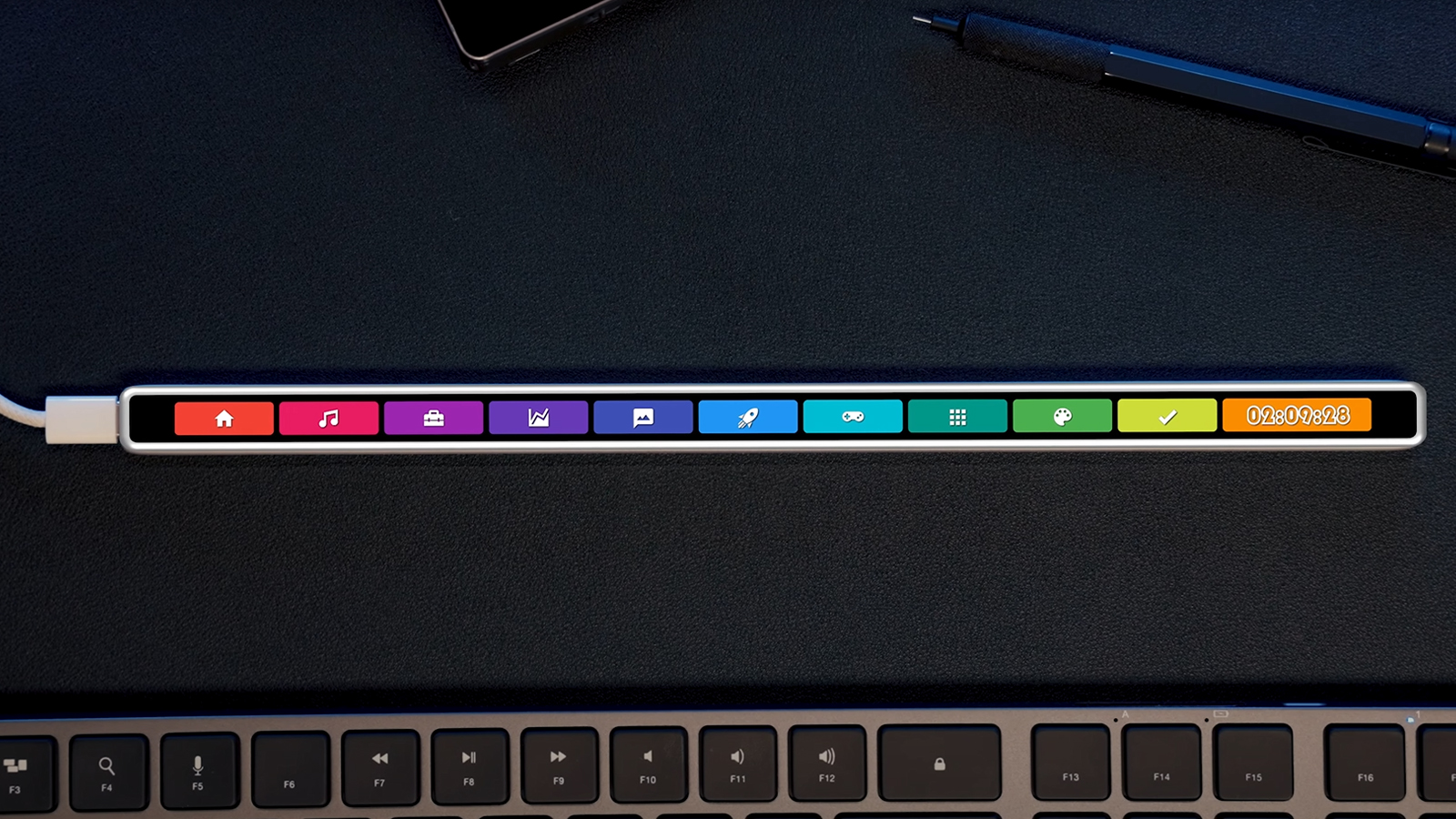Apple Touch Bar turns into a $119 standalone gadget — Flexbar features a 10-inch aluminum body with a 2K AMOLED display that communicates with a USB-C cable
This little gadget solves everything that went wrong with Apple's implementation.

The Apple Touch Bar received generally negative reviews, but it seems it was a good idea with poor execution. So, ENIAC built one as a standalone device, making it a fully customizable and adaptive shortcut bar. This nearly 10-inch aluminum bar with a 2K AMOLED display connects to your computer, tablet, or phone via a USB-C cable, giving you almost every shortcut you can imagine. ENIAC Co-Founder Ray Wenting shared a video X (formerly Twitter) showing the Flexbar working as a media controller and visualizer, but it can do so much more than that.
The Flexbar is like an Elgato Stream Deck, but instead of getting a fixed number of keys and controls, you have a touchscreen interface that you can customize any way you see fit. You could put your most used keys, tools, and shortcuts right on it, and it will change based on your current open window. So, it could be one set of controls when editing a video on Adobe Premiere, and then it’ll automatically change to another when you launch your favorite game.
The touch bar has been turned into a standalone gadget, powered by an ESP32 microcontroller: pic.twitter.com/eDMGutLRI2December 1, 2024
Customizing the toolbar is also much easier, as its makers have already preloaded several shortcut combos and controls for many popular programs, making it a plug-and-play device. It also has third-party API support, allowing it to work almost natively with compatible applications. But if you want it to work your way, the Flexbar will come with a customization tool called FlexbarDesigner. This app lets you personalize it so everything you need will always be within your reach. You could even share your creation with the Flexbar community, allowing you to inspire others.
According to the Flexbar’s Kickstarter page, ENIAC wants “to make Flexbar a joy to use in every way”. So, aside from using premium materials aluminum alloy and 2K OLED screen for the gadget, the team behind it also added a linear motor for haptic feedback, giving you a tactile response with every tap and swipe on the Flexbar. You also get an aluminum magnetic stand to make it easier to see and use and four non-slip silicone pads to prevent the Flexbar from sliding every time you touch it.
This handy little device solves everything that is wrong with Apple’s Touch Bar. It turned it into a removable, portable device you can place anywhere, keeping it away from your keyboard, where it’s prone to getting touched accidentally. It received extra customization features, allowing you to make the most out of it no matter what app you’re using, and it pretty much works with any device, whether it's Windows, macOS, iOS, Android, and more. The only thing we wish it had right now was wireless connectivity, but that might be reserved for a second-generation Flexbar if this nifty little gadget turns out all right.
If you’re interested in the Flexbar, it’s available on Kickstarter for $119, limited to the first 300 buyers and everyone who deposits at least $1 before the gadgets go live. It has an expected regular price of $179.99 and a target delivery date of February 2025. Of course, you should never forget that crowdfunding is not a straight purchase of the item in question, no matter how promising. Instead, you’re investing toward its success, and in exchange for that, you’re getting some nice discounts and being among the first to get the newly launched product.
While Kickstarter will do its best to protect your interests and ensure that you get the device you want, it’s still not a guarantee that you’ll get the device. Sometimes, buying an item after it’s been tested by your trusted reviewers is wiser. That way, you know you’re getting your money’s worth with your purchase.
Get Tom's Hardware's best news and in-depth reviews, straight to your inbox.

Jowi Morales is a tech enthusiast with years of experience working in the industry. He’s been writing with several tech publications since 2021, where he’s been interested in tech hardware and consumer electronics.
-
Giroro If it were built into a keyboard... maybeReply
As a loose widget with it's own wire flopping around on my desk? Nah. -
jonbuder I think the stability of it on a desk is questionable. It looks light enough to me that if the cable were bumped it might get flipped on its side or upside down. The other devices with physical buttons/knobs shouldn't have the same problem.Reply -
Rakanyshu just put the thing on the bottom bevel of a screen, and 200 usd is kinda expensive, you can get a whole keyboard with macro keys for less.Reply -
doomtomb I could probably attach this to the bottom of my monitor, but that's not ergonomic. on the desk it just seems awkward, like too narrow to be useful. I'd prefer a Stream Deck with better buttons. It's a good idea but not the greatest implementation. Wish them best of luck though.Reply -
Notton yeah. the stability looks questionableReply
but that's nothing some 3M VHB tape or nano tape couldn't fix.
stick it on the rear side of the keyboard. -
usertests Reply
I don't have any experience with the original, but I question the ergonomics of this.Giroro said:If it were built into a keyboard... maybe
As a loose widget with it's own wire flopping around on my desk? Nah. -
Kamen Rider Blade The concept was good, the implementation where it tried to replace the F## keys was REALLY bad IMO.Reply
If it was a "Addition" to the F## keys, it would've been fine IMO.
But Apple screwed it up by trying to replace the venerable F## keys.
And support for it was haphazard at best.
Now that it's a independent feature, I think the concept can do just fine as long as support will become open source and accessible on all platforms. -
Lucky_SLS I am sure, ppl will come up with 3D printed bits to dock it above their keyboards soon enough.Reply -
das_stig Reply
Be happy Apple didn't make it, would be north of $500 and fail after 3 months, with them blaming users pressing to and swiping too hard.Rakanyshu said:just put the thing on the bottom bevel of a screen, and 200 usd is kinda expensive, you can get a whole keyboard with macro keys for less.
